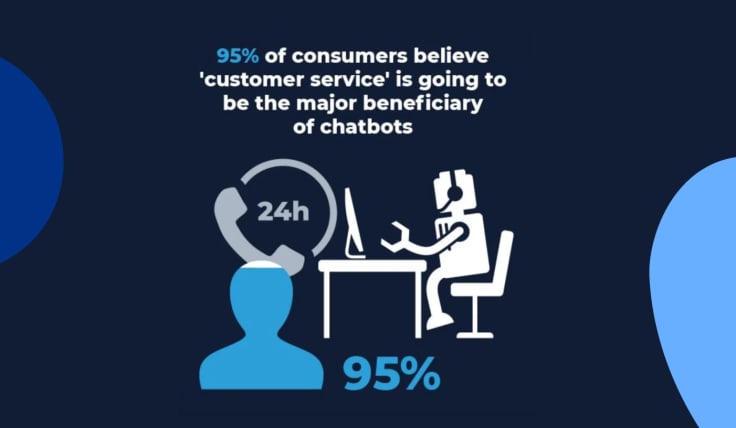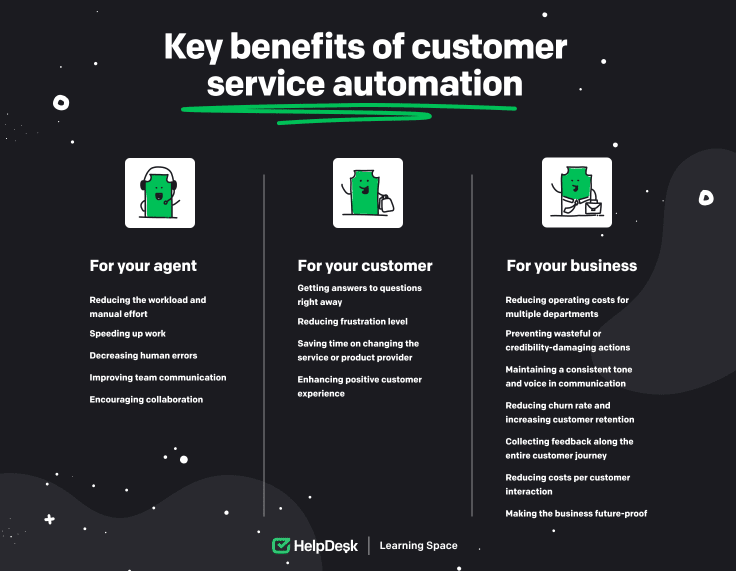Showing top 0 results 0 results found
Showing top 0 results 0 results found

There are many reasons why we may dread getting in touch with customer service. For instance, writer Bill Bryson once wrote, "The other day I called my computer helpline, because I needed to be made to feel ignorant by someone much younger than me." With a properly set up customer service automation, Bryson would only interact with the ever-present, super-patient and polite chatbot. Or an engaging and curious agent, who’s not been jaded by asking clients to turn their unit off and on again, day in, day out.

In ecommerce and customer service, business process automation (BPA) is the latest trend: saving time and money and making life easier for clients - especially when combined with live agent support.
There are many ways to automate your marketing procedures, but here we’ll focus on how to improve customer service operations.
Have too many customer questions to answer on your plate?
Automation is here to stay
The Human Connection study by Verizon Business and Longitude found that our acceptance of machines in customer service is steadily growing, especially among the younger population. This points to the bright future of auto customer service.
Automation is becoming a means to a great customer experience
While relationship building is still best left to humans, transactional interactions can be fully covered by customer service robotization tools. The key to a great customer experience when automating business services is then threefold:
- Carefully consider the customer’s journey so that you apply automated customer service tools where customers will appreciate them most.
- Be transparent about when your customers are interacting with a chatbot.
- Make it easy for the customers to switch to a live agent if they need to and ensure customer satisfaction.
There are a few more tricks to make sure you avoid common chatbot mistakes.

What are the advantages of automating customer service processes?
In my Support Hero days at LiveChat, I often found myself frustrated asking the customer for the upteenth time to refresh the page, or explaining how to view their website in private mode. Only upon reflection do I recognize that these actions were only obvious to me because I used them multiple times a day. When it comes to mundane and frequent customer service tasks, it can be difficult for support teams to put themselves in the customer’s shoes.
Your customers will thank you
One solution would be to invest in regular empathy workshops, another is just delegating these tasks to a chatbot which never gets bored or impatient, regardless of how many times a day (or an hour) it has to deal with the same issue. It can be available 24/7, so the customers get instant assistance, and it can take part in multiple concurrent customer service interactions, so there is no waiting.
Your customer service team will thank you
These are the benefits for the customers, what about your team? They will see a drop in mundane and repetitive tasks, and a drop in the number of chats altogether. Say they would handle six chats at a time before automation, three of which were just run of the mill inquiries, and three were somewhat challenging. Their attention would have to be divided equally between all these chats.
When the simple tasks are taken over by a chatbot, they are left with three more challenging cases at a time. This means that these cases will be resolved quicker, because your agent can actually focus. And the user experience will be better because the agent will actually have time to connect with the customer. This is how you create customer loyalty.
Your business will thank you
When you automate customer service, you:
- shorten the time the clients wait for their issue to be solved,
- make sure that the agents are on their a-game when the customer is triaged to them,
- provide a great experience while reducing customer service costs.
These are just some of the advantages. Customer service automation software makes it easy to maintain consistency. Your customer service crew will have the same tone of voice and provide a dependable level of service throughout the client journey.
Read more about asynchronous customer support automation.

Can automation improve online customer service?
How do you know if your business would benefit from customer support automation? There is more than one way managers can check.
You can look into the analytics of your live chat and check your customer service agents’
- response time,
- daily number of chats,
- and chat satisfaction.
Data analysis shows that, if the number of chats has increased and the response time lengthened, you might benefit from connecting conversation bot to your live chat solution. LiveChat offers robust reporting and integrates with ChatBot seamlessly. You can also ask your service agents, and/or check in the archives of your customer service software, if your team often deals with similar customer queries.

Frequently sent messages can be saved as canned responses, sometimes referred to as premade responses. This is a semi-automation tool available within customer service software, such as LiveChat. This is a step towards automation, where you save frequently used responses. You can read more about the advantages of canned responses, suffice to say that they help your team’s messages to be:
- precise and free of typos.
- consistent with your tone of voice.
- the same quality regardless of how tired your agents are.
Canned responses lend a helping hand and save time, leaving your agents more time to be personal and personable.
If your team is already heavily using canned responses, perhaps it’s time to outsource these repetitive customer interactions to a chatbot. ChatBot integrates with LiveChat and other customer support tools.
For example, when bots were first introduced at LiveChat, they took care of nearly 30% of chats. In the first few months of their adoption they did the work of 19 agents. There are many types of bots that can serve your clients.
How can you improve customer service in ecommerce?
A great example of automation for ecommerce are proactive pop-ups. They can invite visitors to start a conversation with your team at the appropriate time. Or contextually lead them through the actions they need to take on your website or app. With the LiveChat-ChatBot integration, the whole process can be automated, not just the invitation.
LiveChat, for example, offers targeted messages that can be set up for certain conditions, such as a certain time on a product page, visiting a number of product pages in a row, or leaving items in the shopping cart without completing the transaction.
With targeted messages, you can react to the customer’s behavior, without waiting for them to take the initiative and start a chat. For example, you can offer free shipping to a client hesitating to complete a purchase, or offer a discount for a customer who has returned to a product page. The best part is, once they’re set up, they fire automatically whenever their conditions are met.
Automated self service or automated customer service?
The younger generations seem to favor self service to interacting with customer service reps. But self service can still be automated. With the use of targeted messages, you can proactively offer links to your help center or knowledge base.
If a customer hesitates on a particular page or a popular product, why not extend an invitation to check the answer for themselves. Using the integration with LiveChat and KnowledgeBase, you can direct the customers contextually straight to the answer to their question.

The future of business processes is automated.
Automation not only reduces business operating costs, it frees up the time for your agents to create a better customer experience. The main takeaway is to give it a try, test, and iterate. You can’t go wrong with these guidelines:
- Don’t be afraid to automate: approval for automation in customer service is steadily growing. And the younger the respondents, the more enthusiastic they will be, which means that the future is automated.
- Make the distinction between the bot and the human agent clear, and the transition easy for your clients.
- Give your agents extra time and bandwidth to create a great customer experience.
- Monitor analytics: more chats and longer response times mean you will benefit from including a chatbot.
- Check archives and canned responses for the most frequent customer queries and start with automating these.
- Be proactive: contextually prompt visitors to start a chat or take action on your website.
- Automate self-service: suggest resources based on visited pages or questions asked.
Whether your customer interacts with an always-available chatbot, a focused and genuinely interested agent, or a timely suggested resource, they will be delighted.
Have too many customer questions to answer on your plate?



